technical specifications Seat Alhambra 2012 Owner's Manual
[x] Cancel search | Manufacturer: SEAT, Model Year: 2012, Model line: Alhambra, Model: Seat Alhambra 2012Pages: 388, PDF Size: 6.72 MB
Page 6 of 388
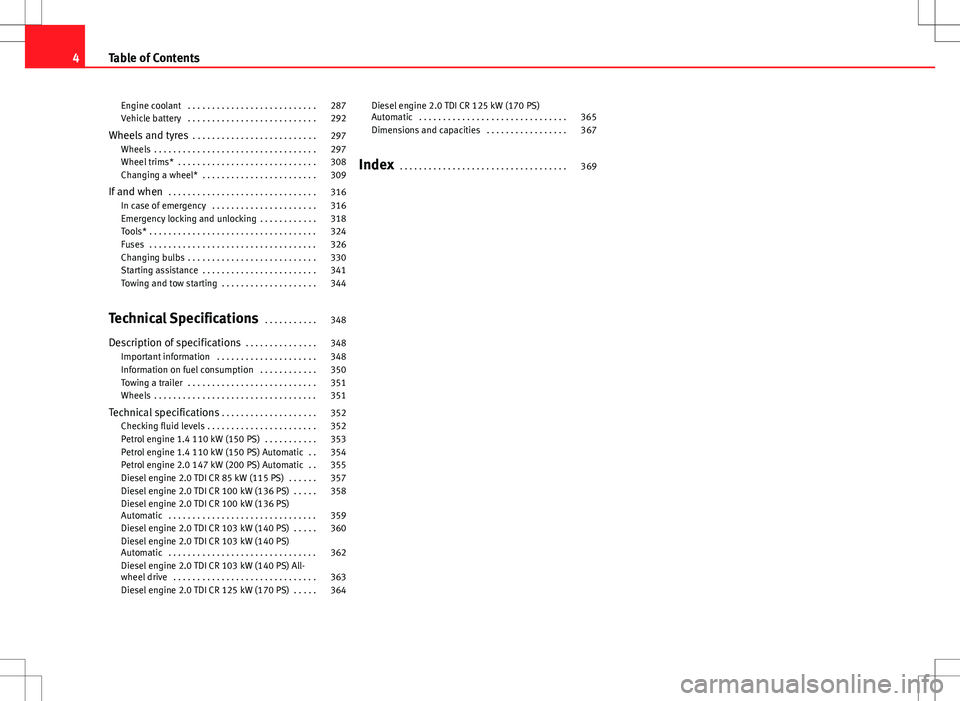
Engine coolant . . . . . . . . . . . . . . . . . . . . . . . . . . . 287
Vehicle battery . . . . . . . . . . . . . . . . . . . . . . . . . . . 292
Wheels and tyres . . . . . . . . . . . . . . . . . . . . . . . . . . 297
Wheels . . . . . . . . . . . . . . . . . . . . . . . . . . . . . . . . . . 297
Wheel trims* . . . . . . . . . . . . . . . . . . . . . . . . . . . . . 308
Changing a wheel* . . . . . . . . . . . . . . . . . . . . . . . . 309
If and when . . . . . . . . . . . . . . . . . . . . . . . . . . . . . . . 316
In case of emergency . . . . . . . . . . . . . . . . . . . . . . 316
Emergency locking and unlocking . . . . . . . . . . . . 318
Tools* . . . . . . . . . . . . . . . . . . . . . . . . . . . . . . . . . . . 324
Fuses . . . . . . . . . . . . . . . . . . . . . . . . . . . . . . . . . . . 326
Changing bulbs . . . . . . . . . . . . . . . . . . . . . . . . . . . 330
Starting assistance . . . . . . . . . . . . . . . . . . . . . . . . 341
Towing and tow starting . . . . . . . . . . . . . . . . . . . . 344
Technical Specifications . . . . . . . . . . . 348
Description of specifications . . . . . . . . . . . . . . . 348
Important information . . . . . . . . . . . . . . . . . . . . . 348
Information on fuel consumption . . . . . . . . . . . . 350
Towing a trailer . . . . . . . . . . . . . . . . . . . . . . . . . . . 351
Wheels . . . . . . . . . . . . . . . . . . . . . . . . . . . . . . . . . . 351
Technical specifications . . . . . . . . . . . . . . . . . . . . 352
Checking fluid levels . . . . . . . . . . . . . . . . . . . . . . . 352
Petrol engine 1.4 110 kW (150 PS) . . . . . . . . . . . 353
Petrol engine 1.4 110 kW (150 PS) Automatic . . 354
Petrol engine 2.0 147 kW (200 PS) Automatic . . 355
Diesel engine 2.0 TDI CR 85 kW (115 PS) . . . . . . 357
Diesel engine 2.0 TDI CR 100 kW (136 PS) . . . . . 358
Diesel engine 2.0 TDI CR 100 kW (136 PS)
Automatic . . . . . . . . . . . . . . . . . . . . . . . . . . . . . . . 359
Diesel engine 2.0 TDI CR 103 kW (140 PS) . . . . . 360
Diesel engine 2.0 TDI CR 103 kW (140 PS)
Automatic . . . . . . . . . . . . . . . . . . . . . . . . . . . . . . . 362
Diesel engine 2.0 TDI CR 103 kW (140 PS) All-
wheel drive . . . . . . . . . . . . . . . . . . . . . . . . . . . . . . 363
Diesel engine 2.0 TDI CR 125 kW (170 PS) . . . . . 364 Diesel engine 2.0 TDI CR 125 kW (170 PS)
Automatic . . . . . . . . . . . . . . . . . . . . . . . . . . . . . . . 365
Dimensions and capacities . . . . . . . . . . . . . . . . . 367
Index . . . . . . . . . . . . . . . . . . . . . . . . . . . . . . . . . . . 369
4Table of Contents
Page 8 of 388
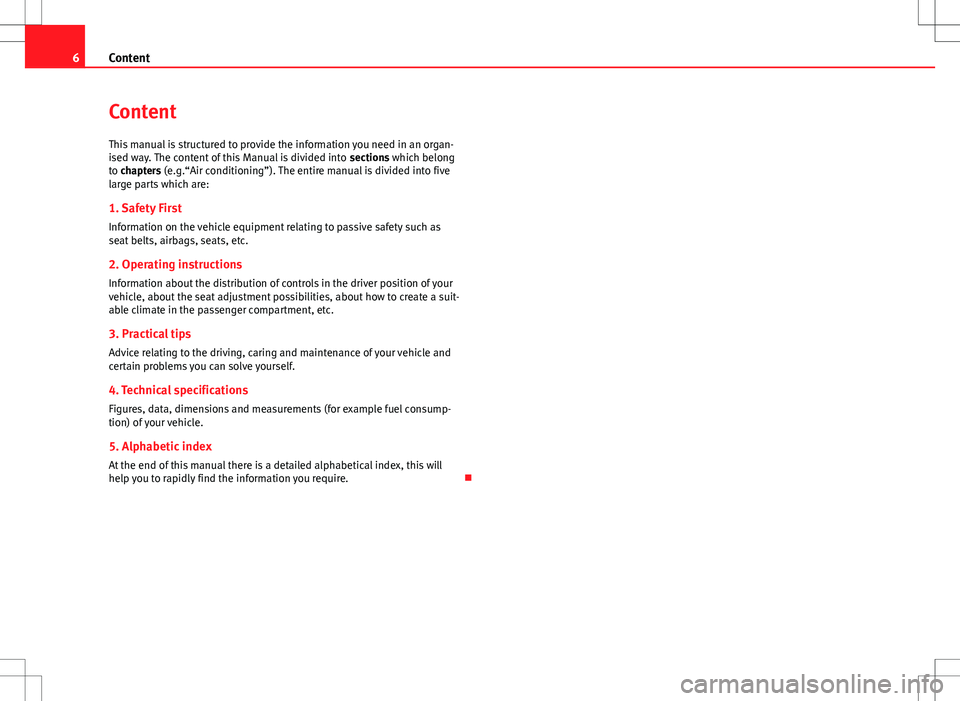
6Content
Content
This manual is structured to provide the information you need in an organ-
ised way. The content of this Manual is divided into sections which belong
to chapters (e.g.“Air conditioning”). The entire manual is divided into five
large parts which are:
1. Safety First Information on the vehicle equipment relating to passive safety such as
seat belts, airbags, seats, etc.
2. Operating instructions
Information about the distribution of controls in the driver position of your
vehicle, about the seat adjustment possibilities, about how to create a suit-
able climate in the passenger compartment, etc.
3. Practical tips
Advice relating to the driving, caring and maintenance of your vehicle and
certain problems you can solve yourself.
4. Technical specifications Figures, data, dimensions and measurements (for example fuel consump-
tion) of your vehicle.
5. Alphabetic index At the end of this manual there is a detailed alphabetical index, this will
help you to rapidly find the information you require.
Page 9 of 388
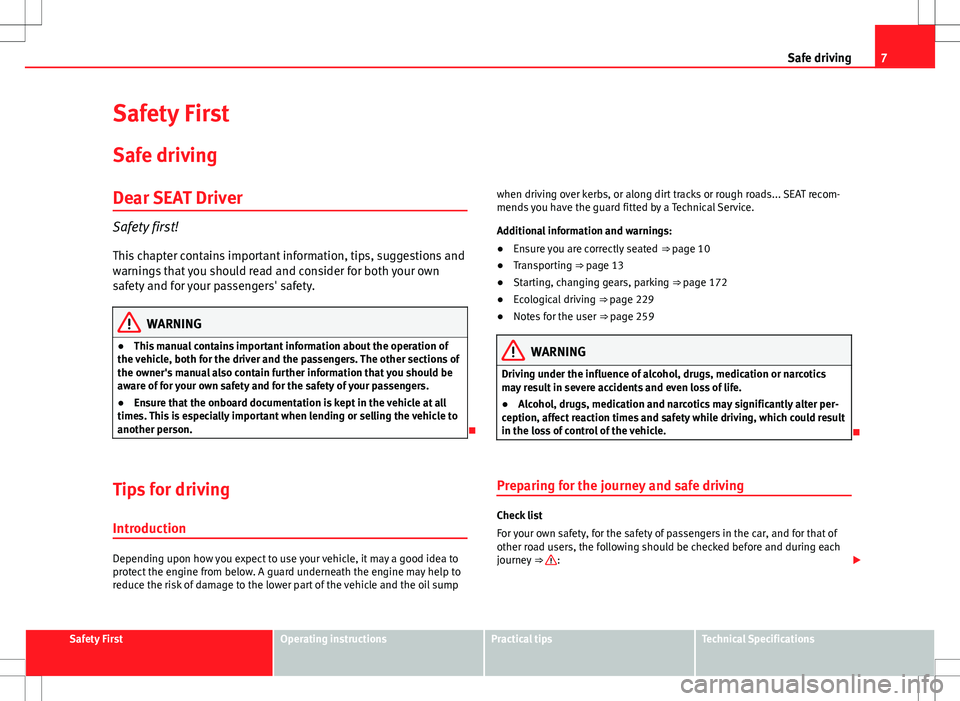
7
Safe driving
Safety First
Safe driving
Dear SEAT Driver
Safety first!This chapter contains important information, tips, suggestions and
warnings that you should read and consider for both your own
safety and for your passengers' safety.
WARNING
● This manual contains important information about the operation of
the vehicle, both for the driver and the passengers. The other sections of
the owner's manual also contain further information that you should be
aware of for your own safety and for the safety of your passengers.
● Ensure that the onboard documentation is kept in the vehicle at all
times. This is especially important when lending or selling the vehicle to
another person.
Tips for driving Introduction
Depending upon how you expect to use your vehicle, it may a good idea to
protect the engine from below. A guard underneath the engine may help to
reduce the risk of damage to the lower part of the vehicle and the oil sump when driving over kerbs, or along dirt tracks or rough roads... SEAT recom-
mends you have the guard fitted by a Technical Service.
Additional information and warnings:
●
Ensure you are correctly seated ⇒ page 10
● Transporting ⇒ page 13
● Starting, changing gears, parking ⇒ page 172
● Ecological driving ⇒ page 229
● Notes for the user ⇒ page 259
WARNING
Driving under the influence of alcohol, drugs, medication or narcotics
may result in severe accidents and even loss of life.
● Alcohol, drugs, medication and narcotics may significantly alter per-
ception, affect reaction times and safety while driving, which could result
in the loss of control of the vehicle.
Preparing for the journey and safe driving
Check list
For your own safety, for the safety of passengers in the car, and for that of
other road users, the following should be checked before and during each
journey ⇒
:
Safety FirstOperating instructionsPractical tipsTechnical Specifications
Page 11 of 388
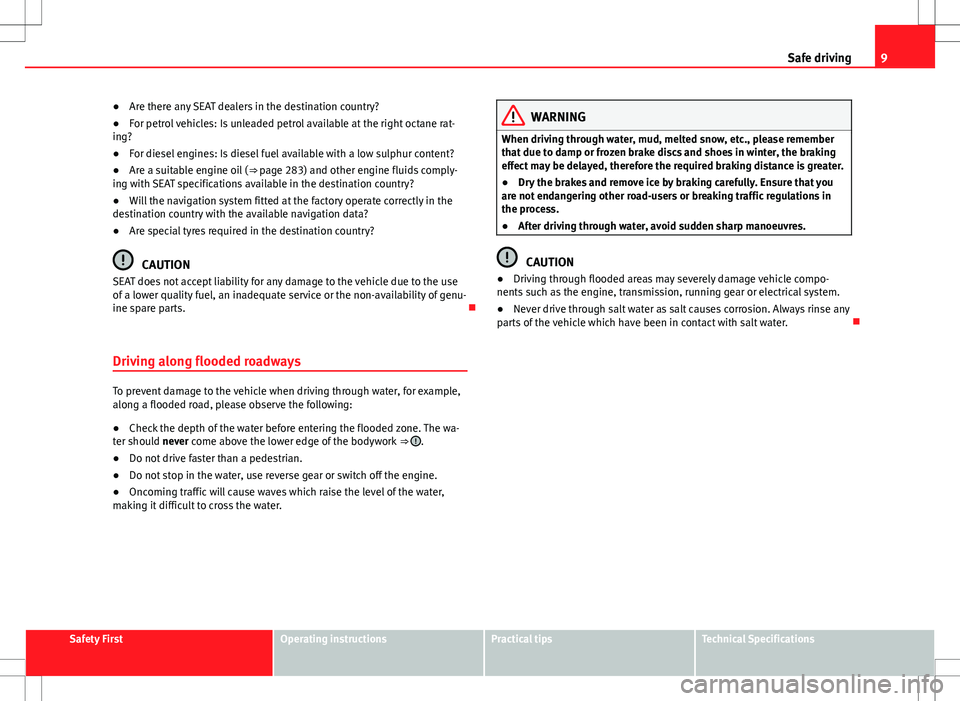
9
Safe driving
● Are there any SEAT dealers in the destination country?
● For petrol vehicles: Is unleaded petrol available at the right octane rat-
ing?
● For diesel engines: Is diesel fuel available with a low sulphur content?
● Are a suitable engine oil ( ⇒ page 283) and other engine fluids comply-
ing with SEAT specifications available in the destination country?
● Will the navigation system fitted at the factory operate correctly in the
destination country with the available navigation data?
● Are special tyres required in the destination country?
CAUTION
SEAT does not accept liability for any damage to the vehicle due to the use
of a lower quality fuel, an inadequate service or the non-availability of genu-
ine spare parts.
Driving along flooded roadways
To prevent damage to the vehicle when driving through water, for example,
along a flooded road, please observe the following:
● Check the depth of the water before entering the flooded zone. The wa-
ter should never come above the lower edge of the bodywork ⇒
.
● Do not drive faster than a pedestrian.
● Do not stop in the water, use reverse gear or switch off the engine.
● Oncoming traffic will cause waves which raise the level of the water,
making it difficult to cross the water.
WARNING
When driving through water, mud, melted snow, etc., please remember
that due to damp or frozen brake discs and shoes in winter, the braking
effect may be delayed, therefore the required braking distance is greater.
● Dry the brakes and remove ice by braking carefully. Ensure that you
are not endangering other road-users or breaking traffic regulations in
the process.
● After driving through water, avoid sudden sharp manoeuvres.
CAUTION
● Driving through flooded areas may severely damage vehicle compo-
nents such as the engine, transmission, running gear or electrical system.
● Never drive through salt water as salt causes corrosion. Always rinse any
parts of the vehicle which have been in contact with salt water.
Safety FirstOperating instructionsPractical tipsTechnical Specifications
Page 13 of 388
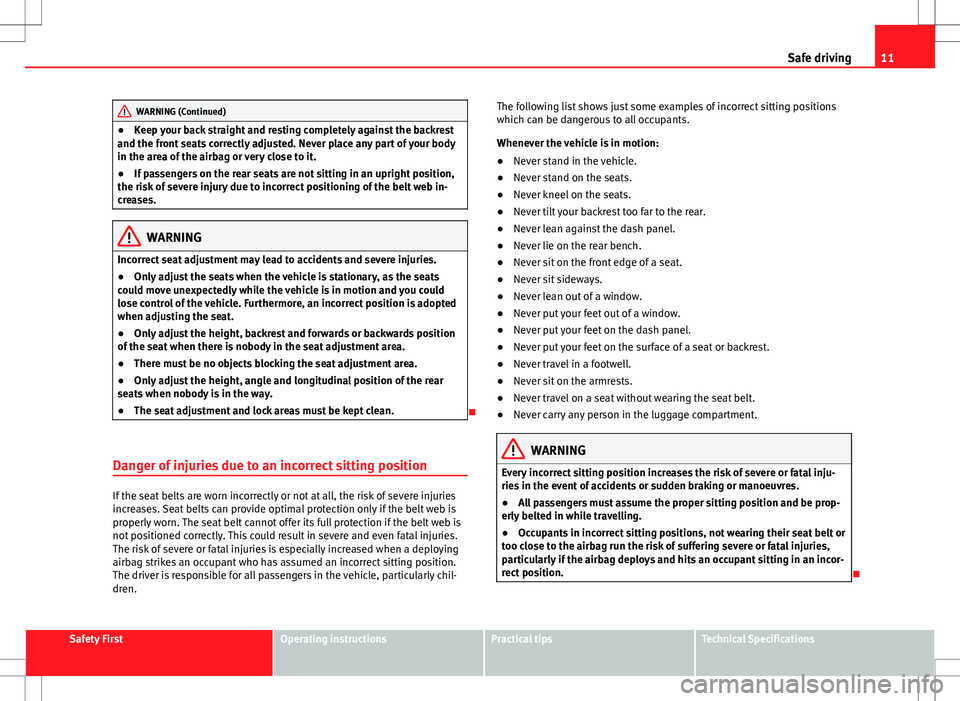
11
Safe driving
WARNING (Continued)
● Keep your back straight and resting completely against the backrest
and the front seats correctly adjusted. Never place any part of your body
in the area of the airbag or very close to it.
● If passengers on the rear seats are not sitting in an upright position,
the risk of severe injury due to incorrect positioning of the belt web in-
creases.
WARNING
Incorrect seat adjustment may lead to accidents and severe injuries.
● Only adjust the seats when the vehicle is stationary, as the seats
could move unexpectedly while the vehicle is in motion and you could
lose control of the vehicle. Furthermore, an incorrect position is adopted
when adjusting the seat.
● Only adjust the height, backrest and forwards or backwards position
of the seat when there is nobody in the seat adjustment area.
● There must be no objects blocking the seat adjustment area.
● Only adjust the height, angle and longitudinal position of the rear
seats when nobody is in the way.
● The seat adjustment and lock areas must be kept clean.
Danger of injuries due to an incorrect sitting position
If the seat belts are worn incorrectly or not at all, the risk of severe injuries
increases. Seat belts can provide optimal protection only if the belt web is
properly worn. The seat belt cannot offer its full protection if the belt web is
not positioned correctly. This could result in severe and even fatal injuries.
The risk of severe or fatal injuries is especially increased when a deploying
airbag strikes an occupant who has assumed an incorrect sitting position.
The driver is responsible for all passengers in the vehicle, particularly chil-
dren. The following list shows just some examples of incorrect sitting positions
which can be dangerous to all occupants.
Whenever the vehicle is in motion:
●
Never stand in the vehicle.
● Never stand on the seats.
● Never kneel on the seats.
● Never tilt your backrest too far to the rear.
● Never lean against the dash panel.
● Never lie on the rear bench.
● Never sit on the front edge of a seat.
● Never sit sideways.
● Never lean out of a window.
● Never put your feet out of a window.
● Never put your feet on the dash panel.
● Never put your feet on the surface of a seat or backrest.
● Never travel in a footwell.
● Never sit on the armrests.
● Never travel on a seat without wearing the seat belt.
● Never carry any person in the luggage compartment.
WARNING
Every incorrect sitting position increases the risk of severe or fatal inju-
ries in the event of accidents or sudden braking or manoeuvres.
● All passengers must assume the proper sitting position and be prop-
erly belted in while travelling.
● Occupants in incorrect sitting positions, not wearing their seat belt or
too close to the airbag run the risk of suffering severe or fatal injuries,
particularly if the airbag deploys and hits an occupant sitting in an incor-
rect position.
Safety FirstOperating instructionsPractical tipsTechnical Specifications
Page 15 of 388
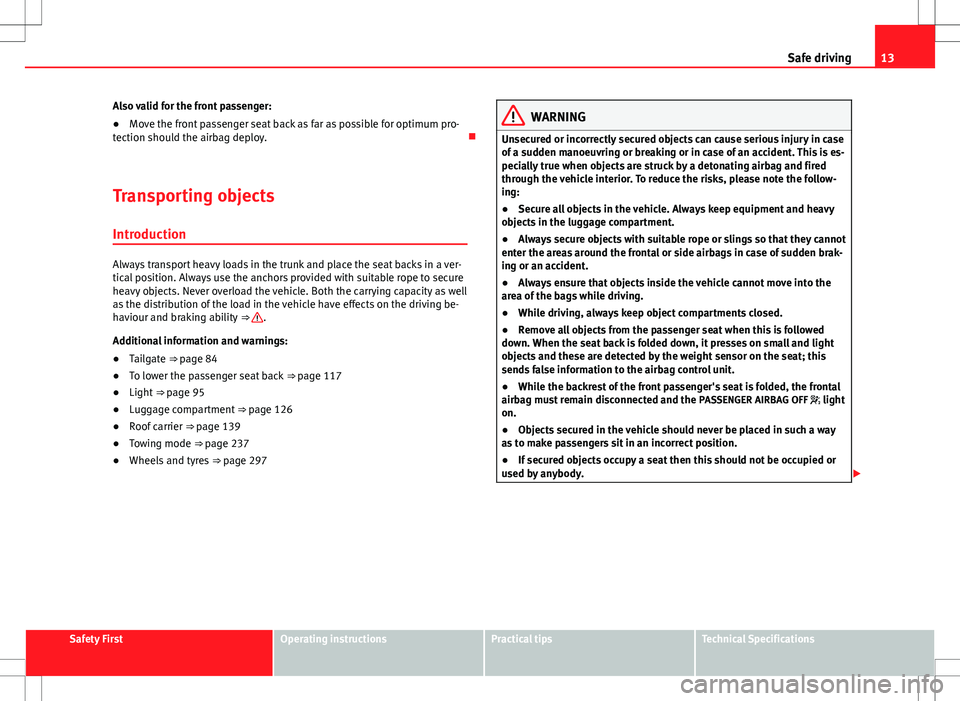
13
Safe driving
Also valid for the front passenger:
● Move the front passenger seat back as far as possible for optimum pro-
tection should the airbag deploy.
Transporting objects Introduction
Always transport heavy loads in the trunk and place the seat backs in a ver-
tical position. Always use the anchors provided with suitable rope to secure
heavy objects. Never overload the vehicle. Both the carrying capacity as well
as the distribution of the load in the vehicle have effects on the driving be-
haviour and braking ability ⇒
.
Additional information and warnings:
● Tailgate ⇒ page 84
● To lower the passenger seat back ⇒ page 117
● Light ⇒ page 95
● Luggage compartment ⇒ page 126
● Roof carrier ⇒ page 139
● Towing mode ⇒ page 237
● Wheels and tyres ⇒ page 297
WARNING
Unsecured or incorrectly secured objects can cause serious injury in case
of a sudden manoeuvring or breaking or in case of an accident. This is es-
pecially true when objects are struck by a detonating airbag and fired
through the vehicle interior. To reduce the risks, please note the follow-
ing:
● Secure all objects in the vehicle. Always keep equipment and heavy
objects in the luggage compartment.
● Always secure objects with suitable rope or slings so that they cannot
enter the areas around the frontal or side airbags in case of sudden brak-
ing or an accident.
● Always ensure that objects inside the vehicle cannot move into the
area of the bags while driving.
● While driving, always keep object compartments closed.
● Remove all objects from the passenger seat when this is followed
down. When the seat back is folded down, it presses on small and light
objects and these are detected by the weight sensor on the seat; this
sends false information to the airbag control unit.
● While the backrest of the front passenger's seat is folded, the frontal
airbag must remain disconnected and the PASSENGER AIRBAG OFF light
on.
● Objects secured in the vehicle should never be placed in such a way
as to make passengers sit in an incorrect position.
● If secured objects occupy a seat then this should not be occupied or
used by anybody.
Safety FirstOperating instructionsPractical tipsTechnical Specifications
Page 17 of 388
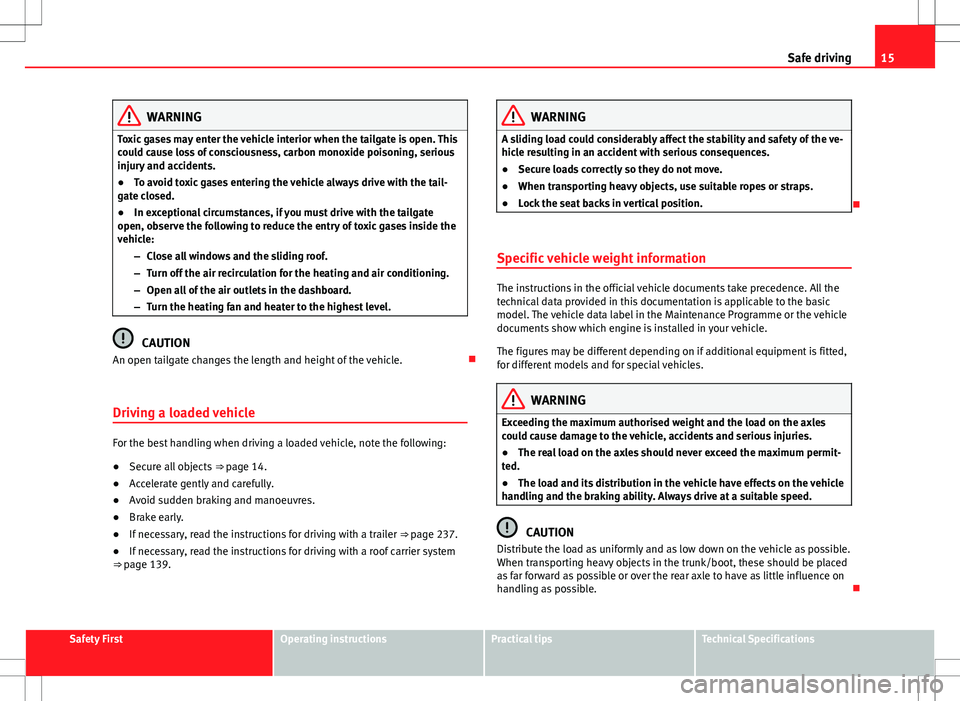
15
Safe driving
WARNING
Toxic gases may enter the vehicle interior when the tailgate is open. This
could cause loss of consciousness, carbon monoxide poisoning, serious
injury and accidents.
● To avoid toxic gases entering the vehicle always drive with the tail-
gate closed.
● In exceptional circumstances, if you must drive with the tailgate
open, observe the following to reduce the entry of toxic gases inside the
vehicle:
–Close all windows and the sliding roof.
– Turn off the air recirculation for the heating and air conditioning.
– Open all of the air outlets in the dashboard.
– Turn the heating fan and heater to the highest level.
CAUTION
An open tailgate changes the length and height of the vehicle.
Driving a loaded vehicle
For the best handling when driving a loaded vehicle, note the following:
● Secure all objects
⇒ page 14.
● Accelerate gently and carefully.
● Avoid sudden braking and manoeuvres.
● Brake early.
● If necessary, read the instructions for driving with a trailer
⇒ page 237.
● If necessary, read the instructions for driving with a roof carrier system
⇒ page 139.
WARNING
A sliding load could considerably affect the stability and safety of the ve-
hicle resulting in an accident with serious consequences.
● Secure loads correctly so they do not move.
● When transporting heavy objects, use suitable ropes or straps.
● Lock the seat backs in vertical position.
Specific vehicle weight information
The instructions in the official vehicle documents take precedence. All the
technical data provided in this documentation is applicable to the basic
model. The vehicle data label in the Maintenance Programme or the vehicle
documents show which engine is installed in your vehicle.
The figures may be different depending on if additional equipment is fitted,
for different models and for special vehicles.
WARNING
Exceeding the maximum authorised weight and the load on the axles
could cause damage to the vehicle, accidents and serious injuries.
● The real load on the axles should never exceed the maximum permit-
ted.
● The load and its distribution in the vehicle have effects on the vehicle
handling and the braking ability. Always drive at a suitable speed.
CAUTION
Distribute the load as uniformly and as low down on the vehicle as possible.
When transporting heavy objects in the trunk/boot, these should be placed
as far forward as possible or over the rear axle to have as little influence on
handling as possible.
Safety FirstOperating instructionsPractical tipsTechnical Specifications
Page 19 of 388
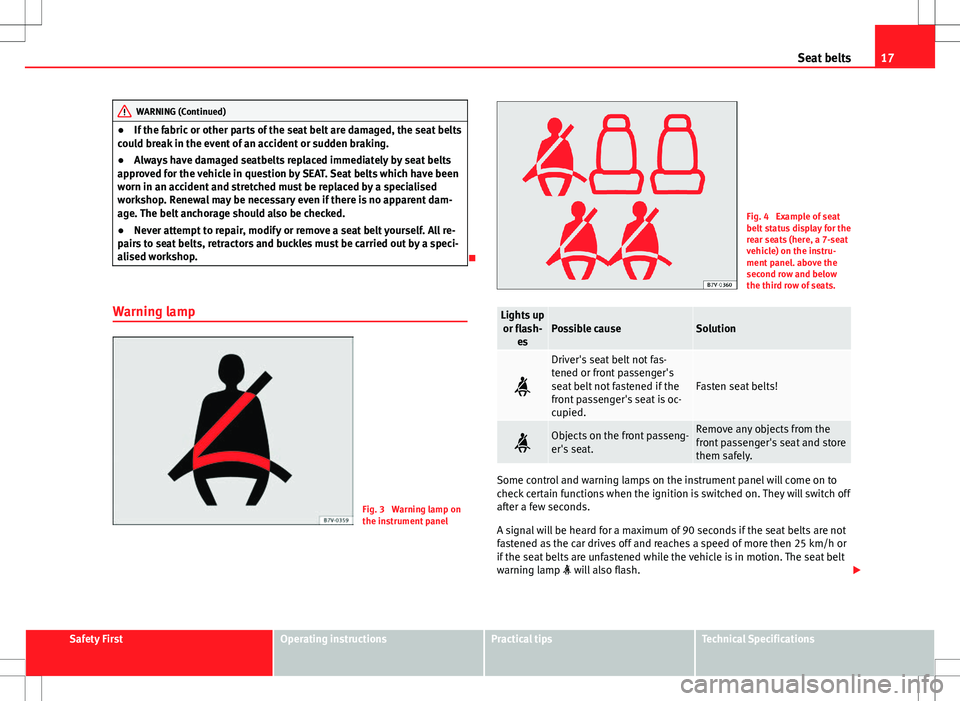
17
Seat belts
WARNING (Continued)
● If the fabric or other parts of the seat belt are damaged, the seat belts
could break in the event of an accident or sudden braking.
● Always have damaged seatbelts replaced immediately by seat belts
approved for the vehicle in question by SEAT. Seat belts which have been
worn in an accident and stretched must be replaced by a specialised
workshop. Renewal may be necessary even if there is no apparent dam-
age. The belt anchorage should also be checked.
● Never attempt to repair, modify or remove a seat belt yourself. All re-
pairs to seat belts, retractors and buckles must be carried out by a speci-
alised workshop.
Warning lamp
Fig. 3 Warning lamp on
the instrument panel
Fig. 4 Example of seat
belt status display for the
rear seats (here, a 7-seat
vehicle) on the instru-
ment panel. above the
second row and below
the third row of seats.
Lights up or flash- esPossible causeSolution
Driver's seat belt not fas-
tened or front passenger's
seat belt not fastened if the
front passenger's seat is oc-
cupied.
Fasten seat belts!
Objects on the front passeng-
er's seat.Remove any objects from the
front passenger's seat and store
them safely.
Some control and warning lamps on the instrument panel will come on to
check certain functions when the ignition is switched on. They will switch off
after a few seconds.
A signal will be heard for a maximum of 90 seconds if the seat belts are not
fastened as the car drives off and reaches a speed of more then 25 km/h or
if the seat belts are unfastened while the vehicle is in motion. The seat belt
warning lamp will also flash.
Safety FirstOperating instructionsPractical tipsTechnical Specifications
Page 21 of 388

19
Seat belts
Why wear seat belts? Frontal collisions and the laws of physics
Fig. 5 Vehicle about to
hit a wall: the occupants
are not wearing seat
belts.
Fig. 6 The vehicle hits
the wall: the occupants
are not wearing seat
belts. It is easy to explain how the laws of physics work in the case of a head-on
collision: when a vehicle starts moving
⇒ fig. 5, this is a certain amount of
energy known as kinetic energy both in the vehicle and in the occupants.
The higher the speed and the greater the weight of the vehicle, the more
energy there is to be absorbed in an accident.
The most significant factor, however, is the speed of the vehicle. If the
speed doubles from 25 km/h to 50 km/h, for example, the kinetic energy is
multiplied by four.
The amount of kinetic energy depends on the speed of the vehicle and the
weight of the vehicle and its passengers. The higher the speed and the
greater the weight of the vehicle and the occupants, the more energy there
is to be absorbed in an accident.
Passengers not wearing seat belts are not “attached” to the vehicle. As a
result, in a frontal collision they will continue to move forward at the speed
their vehicle was travelling just before the impact until something stops
them! Because the passengers in our example are not restrained by seat
belts, all of the passengers' kinetic energy has to be absorbed at the point
of impact ⇒ fig. 6.
At speeds of 30 km/h to 50 km/h, the forces acting on bodies in a collision
can easily exceed one tonne (1000 kg). At greater speed these forces are
even higher.
This example applies not only to head-on collisions, but to all accidents and
collisions.
Safety FirstOperating instructionsPractical tipsTechnical Specifications
Page 23 of 388
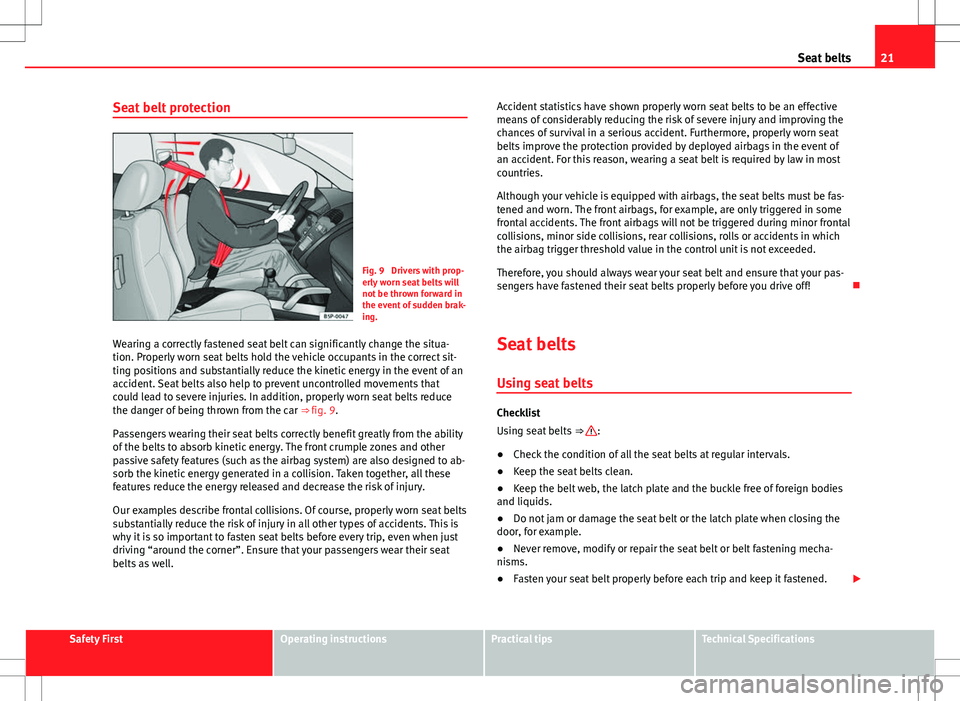
21
Seat belts
Seat belt protection
Fig. 9 Drivers with prop-
erly worn seat belts will
not be thrown forward in
the event of sudden brak-
ing.
Wearing a correctly fastened seat belt can significantly change the situa-
tion. Properly worn seat belts hold the vehicle occupants in the correct sit-
ting positions and substantially reduce the kinetic energy in the event of an
accident. Seat belts also help to prevent uncontrolled movements that
could lead to severe injuries. In addition, properly worn seat belts reduce
the danger of being thrown from the car ⇒ fig. 9.
Passengers wearing their seat belts correctly benefit greatly from the ability
of the belts to absorb kinetic energy. The front crumple zones and other
passive safety features (such as the airbag system) are also designed to ab-
sorb the kinetic energy generated in a collision. Taken together, all these
features reduce the energy released and decrease the risk of injury.
Our examples describe frontal collisions. Of course, properly worn seat belts
substantially reduce the risk of injury in all other types of accidents. This is
why it is so important to fasten seat belts before every trip, even when just
driving “around the corner”. Ensure that your passengers wear their seat
belts as well. Accident statistics have shown properly worn seat belts to be an effective
means of considerably reducing the risk of severe injury and improving the
chances of survival in a serious accident. Furthermore, properly worn seat
belts improve the protection provided by deployed airbags in the event of
an accident. For this reason, wearing a seat belt is required by law in most
countries.
Although your vehicle is equipped with airbags, the seat belts must be fas-
tened and worn. The front airbags, for example, are only triggered in some
frontal accidents. The front airbags will not be triggered during minor frontal
collisions, minor side collisions, rear collisions, rolls or accidents in which
the airbag trigger threshold value in the control unit is not exceeded.
Therefore, you should always wear your seat belt and ensure that your pas-
sengers have fastened their seat belts properly before you drive off!
Seat belts Using seat belts
Checklist
Using seat belts ⇒ :
● Check the condition of all the seat belts at regular intervals.
● Keep the seat belts clean.
● Keep the belt web, the latch plate and the buckle free of foreign bodies
and liquids.
● Do not jam or damage the seat belt or the latch plate when closing the
door, for example.
● Never remove, modify or repair the seat belt or belt fastening mecha-
nisms.
● Fasten your seat belt properly before each trip and keep it fastened.
Safety FirstOperating instructionsPractical tipsTechnical Specifications